1990 VOLVO 240 ECO mode
[x] Cancel search: ECO modePage 79 of 143
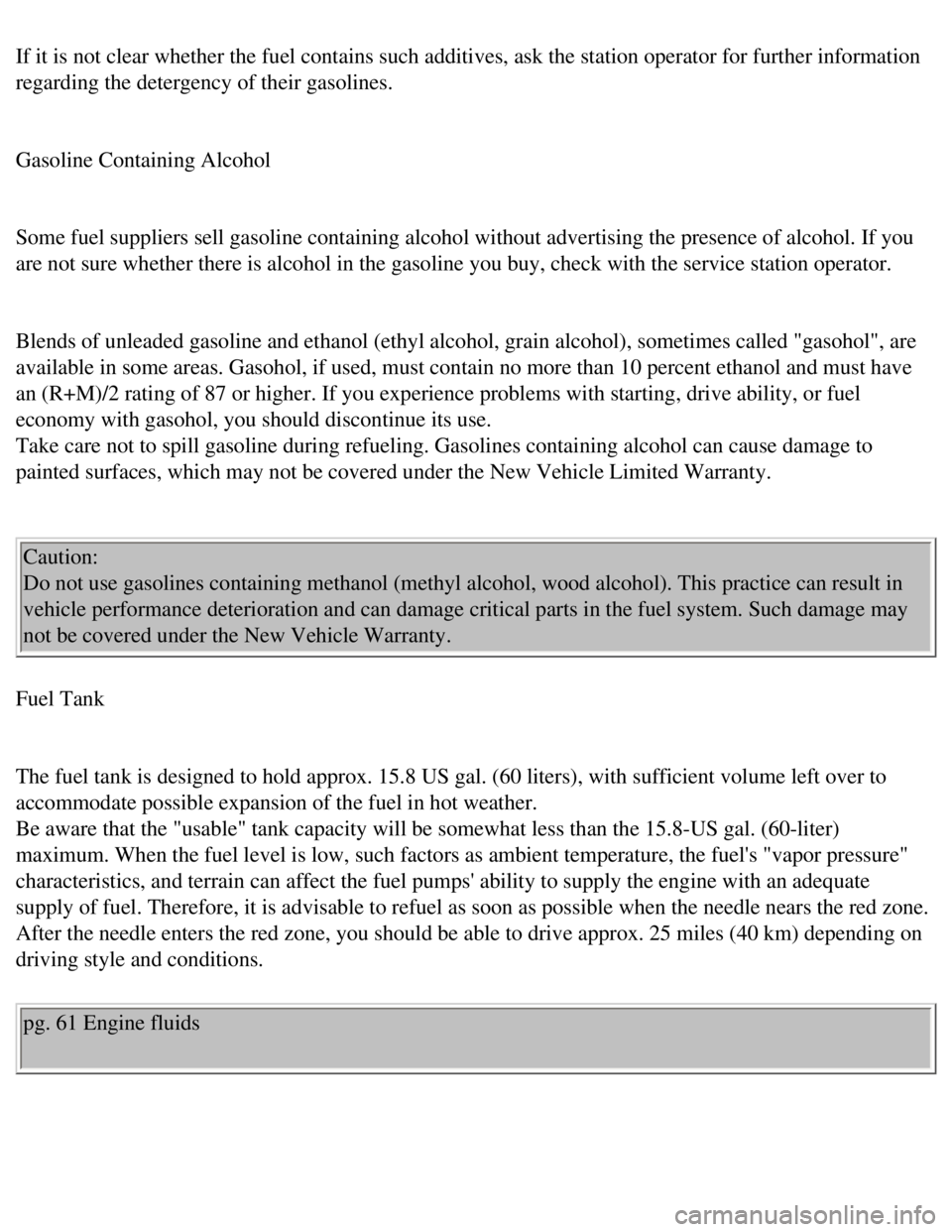
Volvo 1990 240 Model
If it is not clear whether the fuel contains such additives, ask the sta\
tion operator for further information
regarding the detergency of their gasolines.
Gasoline Containing Alcohol
Some fuel suppliers sell gasoline containing alcohol without advertising\
the presence of alcohol. If you
are not sure whether there is alcohol in the gasoline you buy, check wit\
h the service station operator.
Blends of unleaded gasoline and ethanol (ethyl alcohol, grain alcohol)\
, sometimes called "gasohol", are
available in some areas. Gasohol, if used, must contain no more than 10 \
percent ethanol and must have
an (R+M)/2 rating of 87 or higher. If you experience problems with sta\
rting, drive ability, or fuel
economy with gasohol, you should discontinue its use.
Take care not to spill gasoline during refueling. Gasolines containing a\
lcohol can cause damage to
painted surfaces, which may not be covered under the New Vehicle Limited\
Warranty.
Caution:
Do not use gasolines containing methanol (methyl alcohol, wood alcohol)\
. This practice can result in
vehicle performance deterioration and can damage critical parts in the f\
uel system. Such damage may
not be covered under the New Vehicle Warranty.
Fuel Tank
The fuel tank is designed to hold approx. 15.8 US gal. (60 liters), wi\
th sufficient volume left over to
accommodate possible expansion of the fuel in hot weather.
Be aware that the "usable" tank capacity will be somewhat less than the \
15.8-US gal. (60-liter)
maximum. When the fuel level is low, such factors as ambient temperature\
, the fuel's "vapor pressure"
characteristics, and terrain can affect the fuel pumps' ability to suppl\
y the engine with an adequate
supply of fuel. Therefore, it is advisable to refuel as soon as possible\
when the needle nears the red zone.
After the needle enters the red zone, you should be able to drive approx\
. 25 miles (40 km) depending on
driving style and conditions.
pg. 61 Engine fluids
file:///K|/ownersdocs/1990/1990_240/90240_13.htm (3 of 9)12/30/2006 8:\
25:08 AM
Page 82 of 143
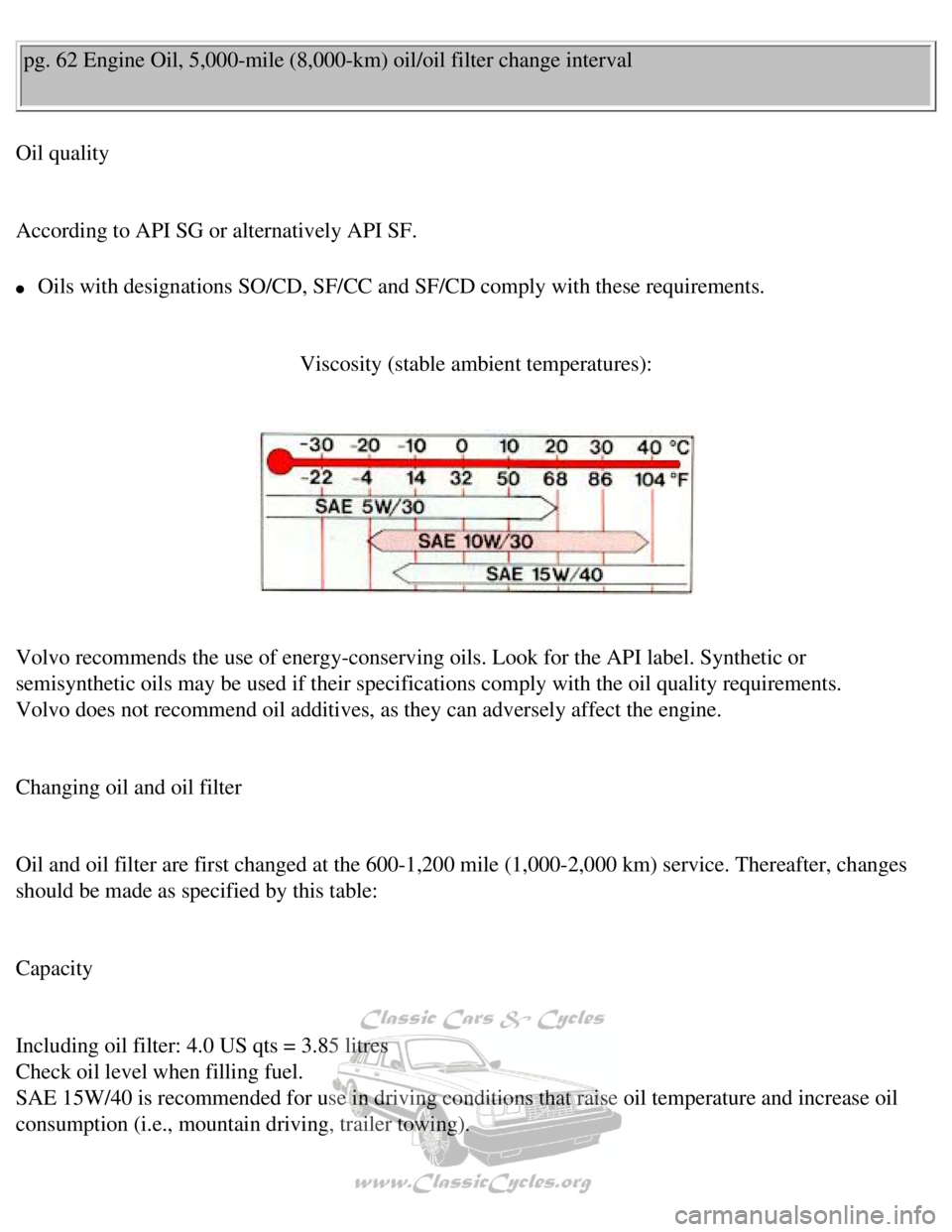
Volvo 1990 240 Model
pg. 62 Engine Oil, 5,000-mile (8,000-km) oil/oil filter change interva\
l
Oil quality
According to API SG or alternatively API SF.
l Oils with designations SO/CD, SF/CC and SF/CD comply with these requirem\
ents.
Viscosity (stable ambient temperatures):
Volvo recommends the use of energy-conserving oils. Look for the API lab\
el. Synthetic or
semisynthetic oils may be used if their specifications comply with the o\
il quality requirements.
Volvo does not recommend oil additives, as they can adversely affect the\
engine.
Changing oil and oil filter
Oil and oil filter are first changed at the 600-1,200 mile (1,000-2,000\
km) service. Thereafter, changes
should be made as specified by this table:
Capacity
Including oil filter: 4.0 US qts = 3.85 litres
Check oil level when filling fuel.
SAE 15W/40 is recommended for use in driving conditions that raise oil t\
emperature and increase oil
consumption (i.e., mountain driving, trailer towing).
file:///K|/ownersdocs/1990/1990_240/90240_13.htm (6 of 9)12/30/2006 8:\
25:08 AM
Page 83 of 143
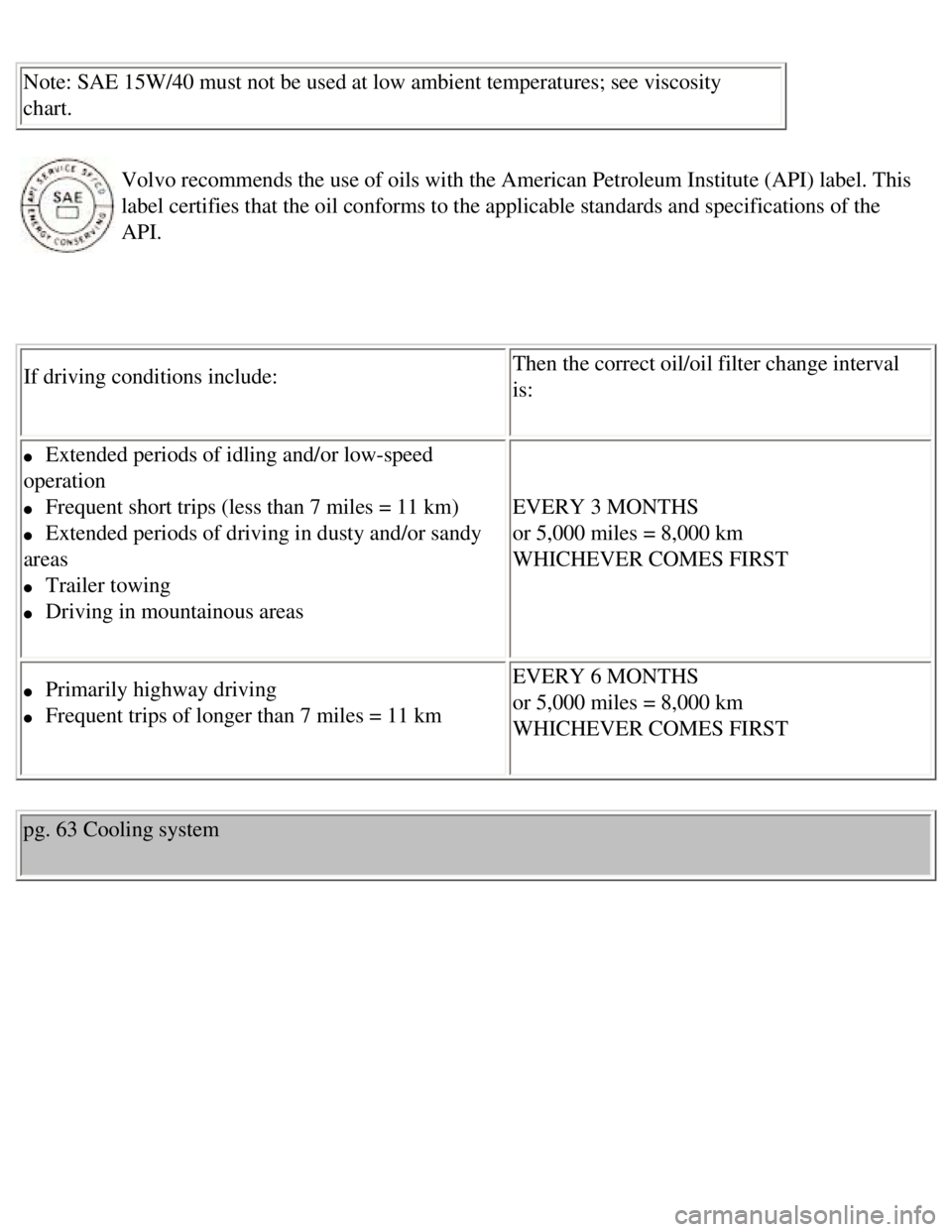
Volvo 1990 240 Model
Note: SAE 15W/40 must not be used at low ambient temperatures; see visco\
sity
chart.
Volvo recommends the use of oils with the American Petroleum Institute (\
API) label. This
label certifies that the oil conforms to the applicable standards and sp\
ecifications of the
API.
If driving conditions include: Then the correct oil/oil filter change interval
is:
l Extended periods of idling and/or low-speed
operation
l Frequent short trips (less than 7 miles = 11 km)
l Extended periods of driving in dusty and/or sandy
areas
l Trailer towing
l Driving in mountainous areas EVERY 3 MONTHS
or 5,000 miles = 8,000 km
WHICHEVER COMES FIRST
l Primarily highway driving
l Frequent trips of longer than 7 miles = 11 km
EVERY 6 MONTHS
or 5,000 miles = 8,000 km
WHICHEVER COMES FIRST
pg. 63 Cooling system
file:///K|/ownersdocs/1990/1990_240/90240_13.htm (7 of 9)12/30/2006 8:\
25:08 AM
Page 86 of 143
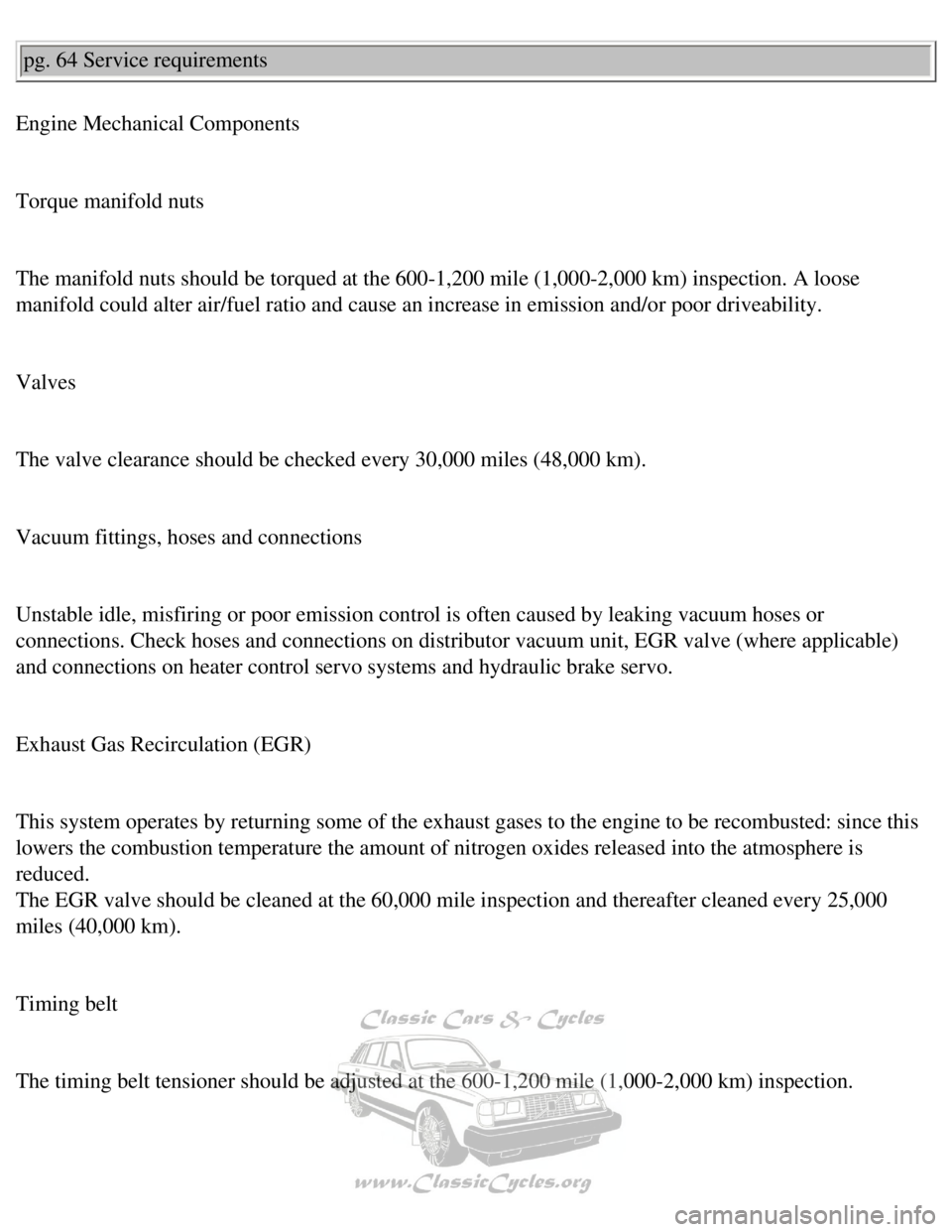
Volvo 1990 240 Model
pg. 64 Service requirements
Engine Mechanical Components
Torque manifold nuts
The manifold nuts should be torqued at the 600-1,200 mile (1,000-2,000 \
km) inspection. A loose
manifold could alter air/fuel ratio and cause an increase in emission an\
d/or poor driveability.
Valves
The valve clearance should be checked every 30,000 miles (48,000 km). \
Vacuum fittings, hoses and connections
Unstable idle, misfiring or poor emission control is often caused by lea\
king vacuum hoses or
connections. Check hoses and connections on distributor vacuum unit, EGR\
valve (where applicable)
and connections on heater control servo systems and hydraulic brake serv\
o.
Exhaust Gas Recirculation (EGR)
This system operates by returning some of the exhaust gases to the engin\
e to be recombusted: since this
lowers the combustion temperature the amount of nitrogen oxides released\
into the atmosphere is
reduced.
The EGR valve should be cleaned at the 60,000 mile inspection and therea\
fter cleaned every 25,000
miles (40,000 km).
Timing belt
The timing belt tensioner should be adjusted at the 600-1,200 mile (1,0\
00-2,000 km) inspection.
file:///K|/ownersdocs/1990/1990_240/90240_14.htm (1 of 7)12/30/2006 8:\
25:08 AM
Page 87 of 143
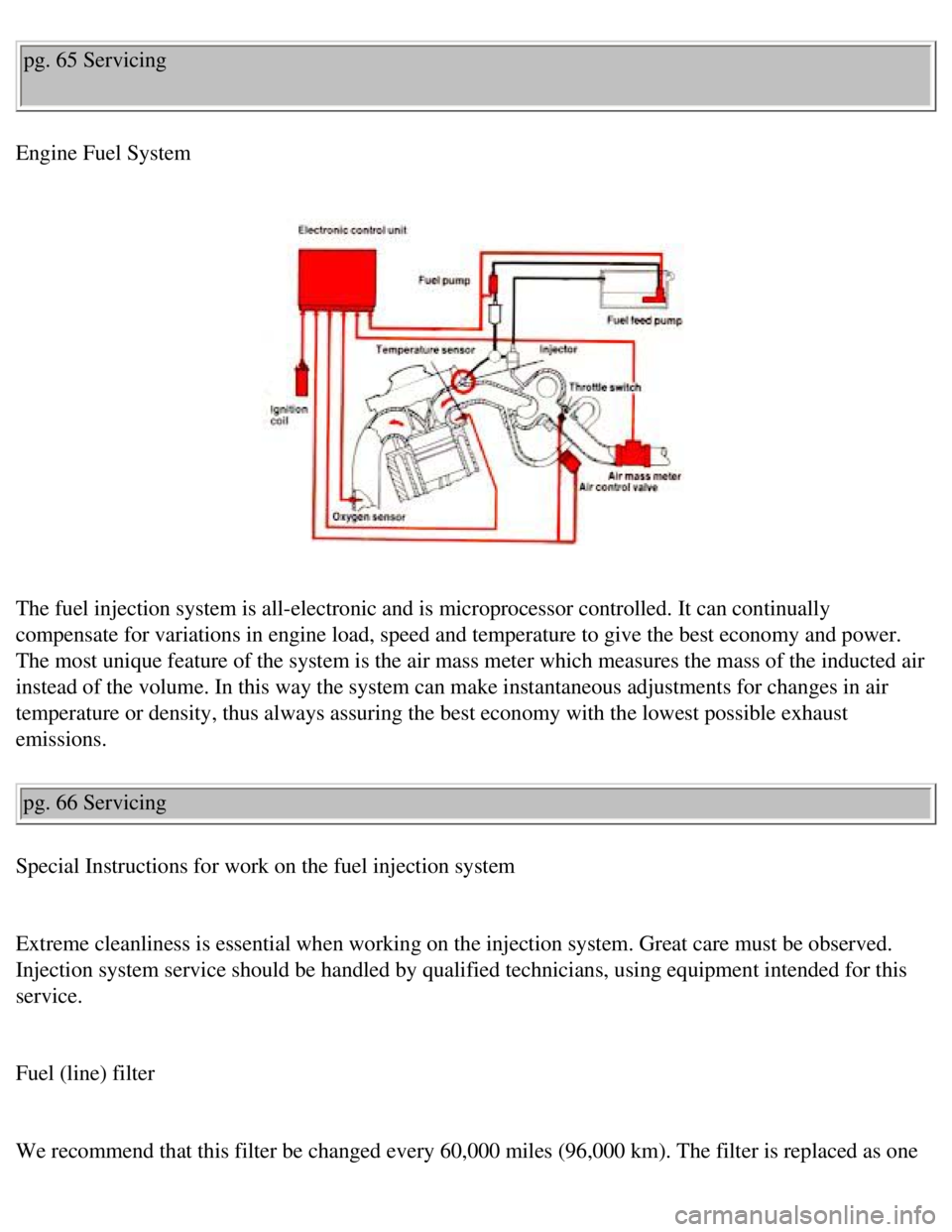
Volvo 1990 240 Model
pg. 65 Servicing
Engine Fuel System
The fuel injection system is all-electronic and is microprocessor contro\
lled. It can continually
compensate for variations in engine load, speed and temperature to give \
the best economy and power.
The most unique feature of the system is the air mass meter which measur\
es the mass of the inducted air
instead of the volume. In this way the system can make instantaneous adj\
ustments for changes in air
temperature or density, thus always assuring the best economy with the l\
owest possible exhaust
emissions. pg. 66 Servicing
Special Instructions for work on the fuel injection system
Extreme cleanliness is essential when working on the injection system. G\
reat care must be observed.
Injection system service should be handled by qualified technicians, usi\
ng equipment intended for this
service.
Fuel (line) filter
We recommend that this filter be changed every 60,000 miles (96,000 km)\
. The filter is replaced as one
file:///K|/ownersdocs/1990/1990_240/90240_14.htm (2 of 7)12/30/2006 8:\
25:08 AM
Page 88 of 143
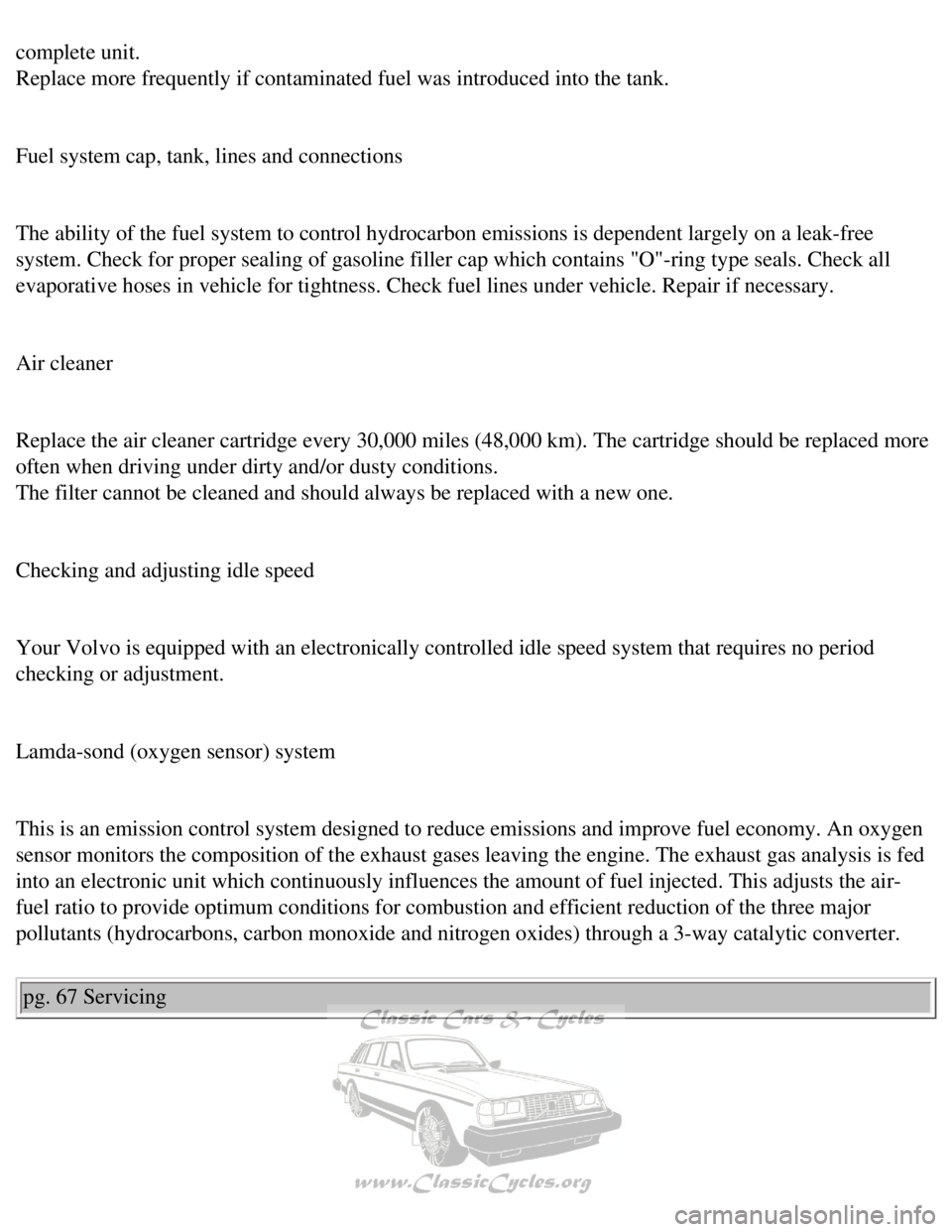
Volvo 1990 240 Model
complete unit.
Replace more frequently if contaminated fuel was introduced into the tan\
k.
Fuel system cap, tank, lines and connections
The ability of the fuel system to control hydrocarbon emissions is depen\
dent largely on a leak-free
system. Check for proper sealing of gasoline filler cap which contains "\
O"-ring type seals. Check all
evaporative hoses in vehicle for tightness. Check fuel lines under vehic\
le. Repair if necessary.
Air cleaner
Replace the air cleaner cartridge every 30,000 miles (48,000 km). The \
cartridge should be replaced more
often when driving under dirty and/or dusty conditions.
The filter cannot be cleaned and should always be replaced with a new on\
e.
Checking and adjusting idle speed
Your Volvo is equipped with an electronically controlled idle speed syst\
em that requires no period
checking or adjustment.
Lamda-sond (oxygen sensor) system
This is an emission control system designed to reduce emissions and impr\
ove fuel economy. An oxygen
sensor monitors the composition of the exhaust gases leaving the engine.\
The exhaust gas analysis is fed
into an electronic unit which continuously influences the amount of fuel\
injected. This adjusts the air-
fuel ratio to provide optimum conditions for combustion and efficient re\
duction of the three major
pollutants (hydrocarbons, carbon monoxide and nitrogen oxides) through\
a 3-way catalytic converter. pg. 67 Servicing
file:///K|/ownersdocs/1990/1990_240/90240_14.htm (3 of 7)12/30/2006 8:\
25:08 AM
Page 89 of 143
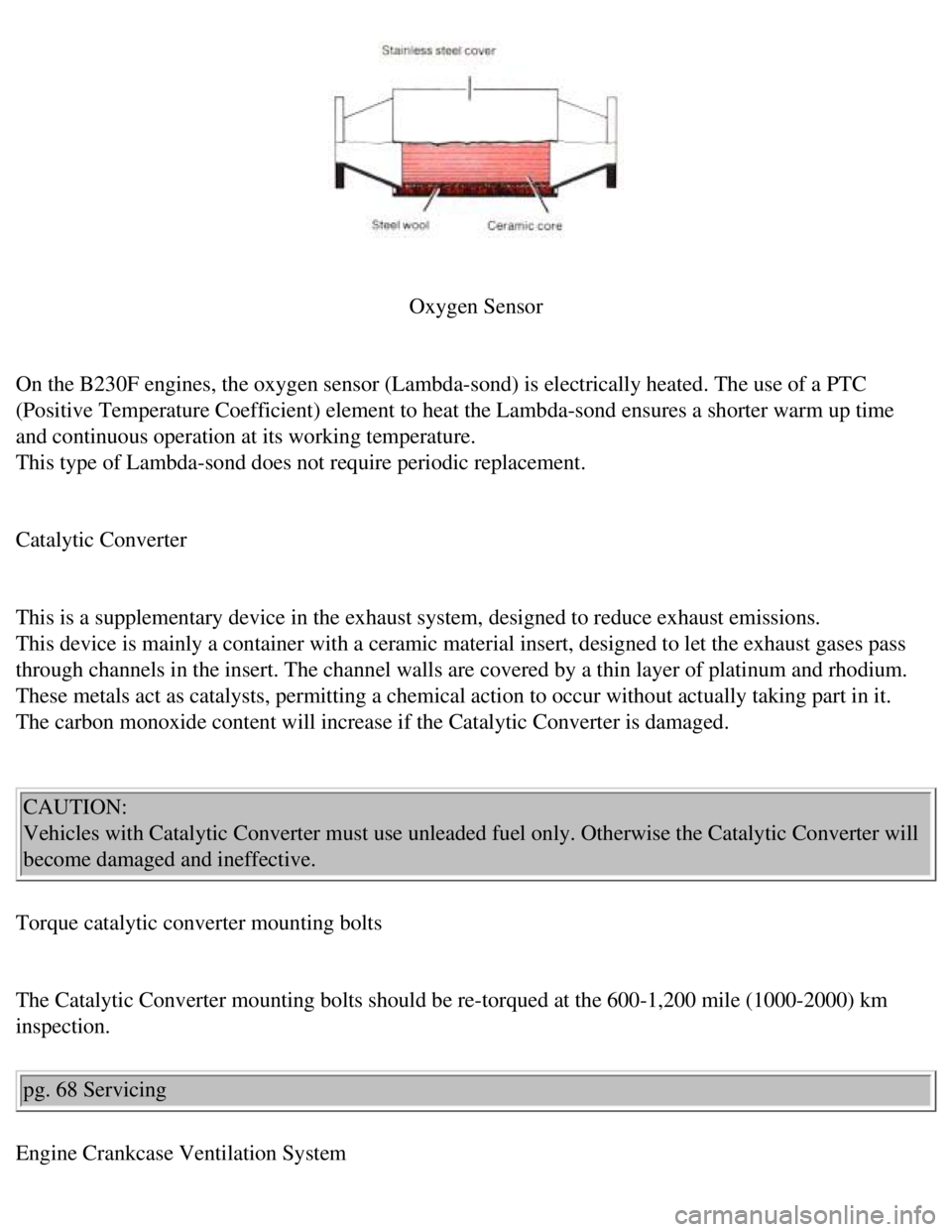
Volvo 1990 240 Model
Oxygen Sensor
On the B230F engines, the oxygen sensor (Lambda-sond) is electrically \
heated. The use of a PTC
(Positive Temperature Coefficient) element to heat the Lambda-sond ens\
ures a shorter warm up time
and continuous operation at its working temperature.
This type of Lambda-sond does not require periodic replacement.
Catalytic Converter
This is a supplementary device in the exhaust system, designed to reduce\
exhaust emissions.
This device is mainly a container with a ceramic material insert, design\
ed to let the exhaust gases pass
through channels in the insert. The channel walls are covered by a thin \
layer of platinum and rhodium.
These metals act as catalysts, permitting a chemical action to occur wit\
hout actually taking part in it.
The carbon monoxide content will increase if the Catalytic Converter is \
damaged.
CAUTION:
Vehicles with Catalytic Converter must use unleaded fuel only. Otherwise\
the Catalytic Converter will
become damaged and ineffective.
Torque catalytic converter mounting bolts
The Catalytic Converter mounting bolts should be re-torqued at the 600-1\
,200 mile (1000-2000) km
inspection.
pg. 68 Servicing
Engine Crankcase Ventilation System
file:///K|/ownersdocs/1990/1990_240/90240_14.htm (4 of 7)12/30/2006 8:\
25:08 AM
Page 99 of 143
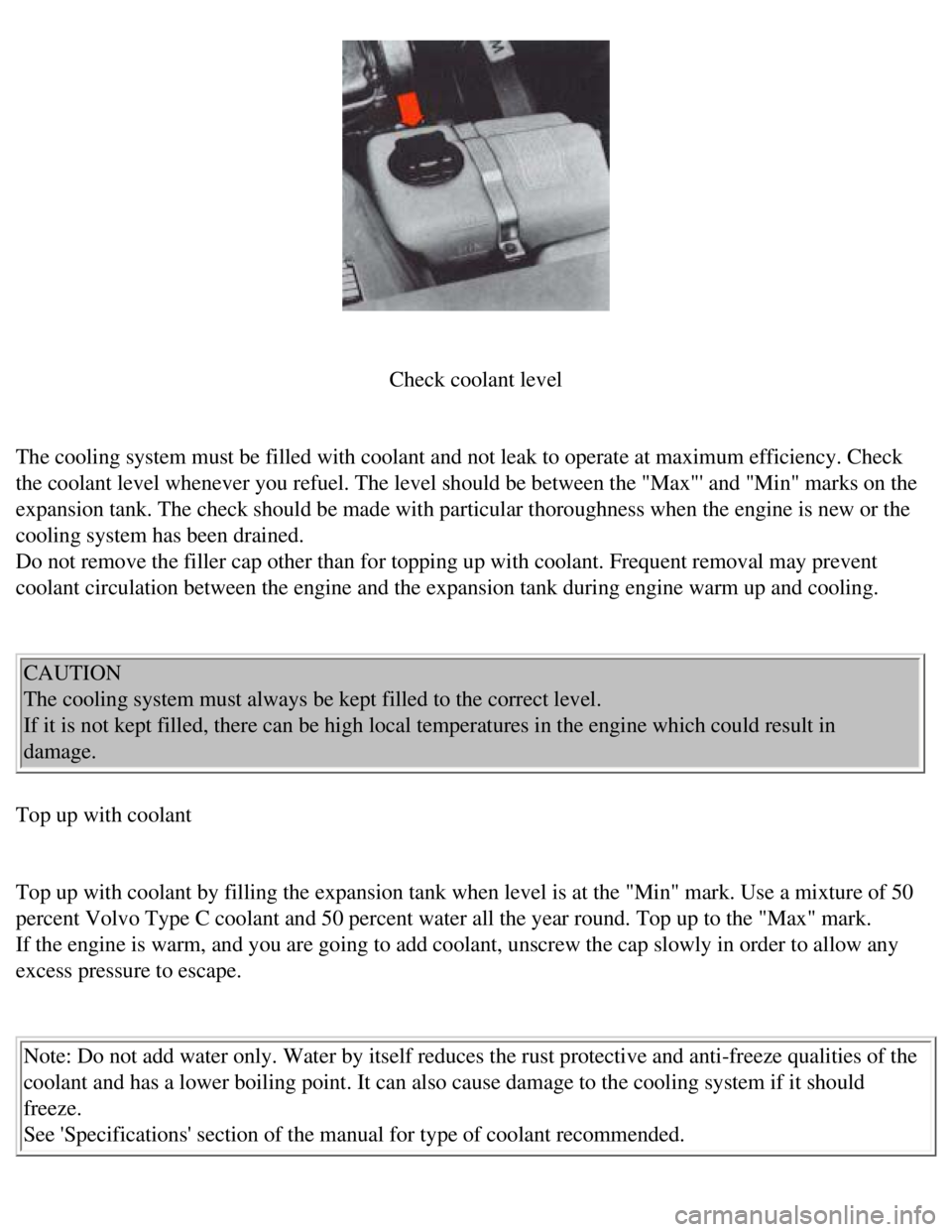
Volvo 1990 240 Model
Check coolant level
The cooling system must be filled with coolant and not leak to operate a\
t maximum efficiency. Check
the coolant level whenever you refuel. The level should be between the "\
Max"' and "Min" marks on the
expansion tank. The check should be made with particular thoroughness wh\
en the engine is new or the
cooling system has been drained.
Do not remove the filler cap other than for topping up with coolant. Fre\
quent removal may prevent
coolant circulation between the engine and the expansion tank during eng\
ine warm up and cooling.
CAUTION
The cooling system must always be kept filled to the correct level.
If it is not kept filled, there can be high local temperatures in the en\
gine which could result in
damage.
Top up with coolant
Top up with coolant by filling the expansion tank when level is at the "\
Min" mark. Use a mixture of 50
percent Volvo Type C coolant and 50 percent water all the year round. To\
p up to the "Max" mark.
If the engine is warm, and you are going to add coolant, unscrew the cap\
slowly in order to allow any
excess pressure to escape.
Note: Do not add water only. Water by itself reduces the rust protective\
and anti-freeze qualities of the
coolant and has a lower boiling point. It can also cause damage to the c\
ooling system if it should
freeze.
See 'Specifications' section of the manual for type of coolant recommend\
ed.
file:///K|/ownersdocs/1990/1990_240/90240_15.htm (7 of 10)12/30/2006 8\
:25:09 AM